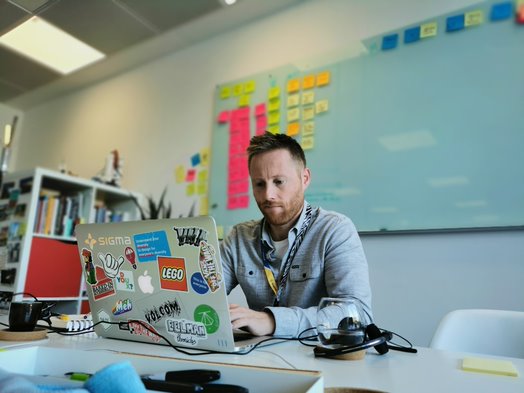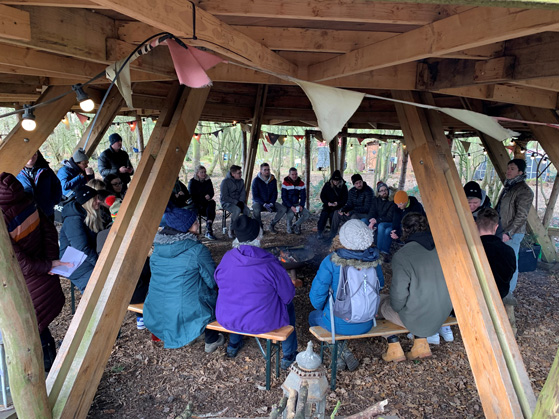Introduction
In the first part of our Mapping the evolution of EdTech report, we revealed the impact EdTech has had on all levels of education, from Early Years through to adult learning, and particularly in light of the pandemic.
Despite a handful of reservations such as concerns around funding and technology's potential to distract learners, the response from those working within education was overwhelmingly positive. Today's educators want access to better EdTech, they understand how it can make a positive difference to their practice, and believe it can both enhance learning in the moment and prepare learners for life after education.
However, behind the tech-enabled buzz of classroom learning sits another group of stakeholders whose opinions of and involvement with EdTech are crucial – the parents, guardians and carers.
While many higher education learners had access to laptops and the tech they needed to learn, younger ages groups and families with multiple school-aged children may have to share hardware with their siblings, and bandwidth with their parents. Did these experiences negatively impact their views of tech-led learning?
In Part two of our report, we explore the experiences this segment has had of supporting their children and young adults with remote learning both during and since the worst of the pandemic.
About the company
Established in 2007, Nexer Digital (formerly Sigma) is a leading digital User Experience (UX) agency that designs digital products and services that help people to live and work better.
Nexer works with organisations large and small, in the public, private and not-for-profit sectors, nationally and internationally. The team believes strongly in developing long term, mutually beneficial strategic partnerships with its customers, with key clients including mental health charity Mind, Astra Zeneca and the Department for Education.
In addition, Nexer also runs the North of England's leading digital UX event – Camp Digital. Now in its tenth year, Camp Digital attracts world-class speakers who discuss the most important topics and trends in the UX and digital community.
Nexer Digital is part of the Nexer Group, a Swedish strategy, technology and communication company with 1,600 employees, driving tech innovation in 9 countries. Nexer Group is part of the Danir Group, a Swedish privately held company with nearly 8,000 employees in 16 countries.


Key findings
Part two of our report explores the experiences of parents, guardians and carers supporting their children and young adults with remote learning, both during and following the worst of the pandemic. Here’s what we found:

Only 18% of learners had sole access to technology that could support their remote learning.
44% of families spent between £101 - £500 on new technology.
35% of low income families didn’t have the home learning equipment they needed in the last lockdown.
41% said their internet had slowed when learners were studying remotely.
80% of parents did not recognise ‘My child has enjoyed learning remotely’ as true.
4% struggled to use the support provided by EdTech teams or tools.

Section 1
Tech-enabled households
When the scale of the Covid-19 crisis became apparent and that it would ultimately lead to school closures, technology's potential to mitigate the worst impact on learning provided hope. However, this potential depended on multiple variables. Access to technology for learning remotely emerged as a key factor that could disrupt the best efforts of educators to provide optimum learning opportunities and experiences for their students. Moreover, children belonging to disadvantaged families risked being left further behind by living with households with a tech deficit.
Access to technology
Our research found that most parents and carers are able to provide their learners with access to technology hardware needed for remote learning. The majority of households (76%) have access to a laptop, 65% to a tablet, and 43% to a PC. Additional hardware such as printers (44%), speakers (35%), and scanners (29%) are less prevalent but are also less critical for enabling remote learning.
However, the availability of technology hardware is impacted by the number of people who need to use it. Only 18% of learners had sole access to technology that could support their remote learning. Over a third of households (34%) had technology that was shared between two learners and in 22%, it was shared between three. In one in 10 households, technology was shared between four or at least five learners preventing simultaneous lessons and learning.
Compatibility and cost
Easy access to technology hardware is rendered almost pointless if it is incompatible with the EdTech a place of education uses. Almost a third of households (31%) had to download or install extra software to support remote learning while more than one in five (22%) had to update existing software. The remaining respondents either didn't have to download or install extra software (20%) or used free platforms (26%) such as Zoom and Microsoft Teams.
Where extra tech was needed to support remote learning, many households had to pick up the tab. In the past 12 months, our research found that over a third of households had managed to keep their spending on new software and/or hardware to less than £100. However, they were in the minority. Most families (44%) spent between £101 - £500 on new technology and just under one in six (16%) spent between £501 - £1,000. 4% had to spend over £1,000.
Lower income families
The extra cost that remote learning presented to families highlights issues around the digital divide and digital education inequality during the pandemic. Research carried out by Child Poverty Action Group and Children North East in 2021 found that 35% of low income families didn't have the home learning equipment they needed in the last lockdown, commonly lacking devices such as laptops and tablets.
For EdTech to be truly advantageous to learners, current barriers for lower-income families need to be removed. Without adequate digital tools, it is challenging for learners to properly participate in classes and as a result, more disadvantaged students are likely to fall further behind, intensifying existing inter-class achievement gaps.
There is an established link between poverty and lower academic performance. In 2019, only 25% of those eligible for free school meals, or who had been in care or adopted from care achieved grades 9-5 in GCSE maths and English, compared with 50% of all other pupils. Those who do not have access to tech in their day-to-day home life may not be as technologically literate as their peers who do, which can further exacerbate performance divide issues.
It is crucial that all learners have access to the tools and platforms needed to progress through education and mitigate the implications of digital exclusion. This means improved access to hardware and financial support for less advantaged learners is fundamental in advancing the benefits of technology in classrooms.
Section 2
Everything hangs on the internet
Of the variables that can impact remote learning, none are so universally impactful as connectivity. Whether a household has access to state-of-the-art technology or donated, legacy technology, whether one learner is using a laptop or it’s shared between five - with no internet, the full promise of remote learning is wiped out for all.

Number of users
The majority of households we researched had multiple individuals using the internet for either remote learning or remote working purposes. For 56%, that was only either one or two. However, for almost one in five households (19%), three people could be using the internet at any one time and in a not insignificant 15%, four or at least five people needed to be online.
Where a household has multiple remote learners, reliable connectivity becomes an even more critical factor. The addition of remote learners to an internet connection being used by a parent or someone else in the household to work also puts the technology to the test. But during the last 12 months, how did connectivity hold up for the households we surveyed?
Connectivity issues
Generally, the picture was not great. Only a third of parents and carers we surveyed (34%) reported that their connectivity was unaffected during the period their learners were studying remotely. Most (41%) said their internet had slowed and a worrying quarter of households (29%) said that while their young person was remote learning, internet connectivity had dropped completely.
Other internet problems in the last 12 months were common too and only 4% reported that they had experienced none at all. Elsewhere, 38% of households experienced a connection issue between two and five times, and 39% experienced between six and 10 issues. Nearly a quarter (24%) had faced more than 10 problems with their internet connection during periods of remote learning.
Section 3
The parental experience of remote learning
As we can see, the experiences households have had with accessing both technology and the connectivity it depends on for remote learning has been mixed. But what of the actual learning itself? What opinions do parents and carers hold towards remote learning? Do they feel it has benefitted their child? And, were they able to help their children use it?
After all, if remote learning is going to become more normalised in the future, parents also need to be able to navigate online learning resources. Our research would look at the parental pressures of using technology and assisting their children with school work.
Challenges and triumphs
We presented our parents and carers with a set of statements relating to remote learning and asked them to consider which they felt was true for their child. The first four statements contained specific challenges children might have faced and, at first glance, the results appear to be concerning. It is only when we look beyond the figures presented does a more optimistic picture emerge.
For example, over a third (34%) of parents and carers reported that their child had difficulty when learning remotely. Although one child struggling is one too many, this does not detract from the fact that 66% of caregivers did not recognise these difficulties with their own children. Similarly, though a quarter (26%) of children had missed a lesson due to technology failure, it means three quarters did not. Whereas 23% of children experienced social difficulties while learning remotely, that left 77% who hadn’t. And though 16% of children lost work progress or a document, it means this was not true for 84%.
Clearly, though the majority of children experienced few difficulties with their remote learning, it is not a big enough majority to hail the experiment a total success. A third of children struggling to learn from home or a quarter missing lessons due to tech failure is unacceptable by any standard. Should schools be forced to close again in the future for whatever reason, targeting those minorities with additional support will be essential.
Nothing compares to the classroom
Ultimately, however sophisticated and immersive remote learning can be, children thrive when around other children and in the physical presence of a skilled educator. Though difficulties with technology had an impact, it was the removal of these two essential factors that delivered the greatest blow.
This was evident in the results from the next four statements parents and carers were asked to consider. With the statement ‘My child has enjoyed learning remotely’, only one in five (20%) of parents and carers recognised this as being true, leaving 80% who felt it was not. Likewise, just 12% said their child’s learning experience improved by using technology.
This became even starker with the statement ‘My child prefers learning remotely to in-person teaching’. Just 7% of parents and carers believed this to be true for their child.
Again, it’s important that we view these findings in context. Rather than using EdTech as a learning tool and as part of wider, classroom-based lessons, children were using it almost exclusively for weeks and weeks at a time. Less a reflection on the technology, any parental aversion to remote learning was more a reflection on the unique circumstances their children were forced to learn in.
Parental proficiency in technology
Of the various changes the pandemic brought to how we live our lives, one of the most keenly felt for many was the abrupt, more formalised role they had in nurturing their children’s education. But for those parents and carers who suddenly had to engage with EdTech, what were their experiences like?
On this front, a more positive story unfolds. Firstly, most parents and carers were in a position to help their children with only 12% claiming they had a lack of time to prepare their child’s technology-based classes.
Of those that did have time, fewer than 1 in five (19%) claimed to have a lack of experience with using EdTech, suggesting that schools had been encouraging them to engage with it prior to the pandemic. A distinct minority (19%) also claimed to have struggled with the EdTech their child had been given to learn with and fewer still (14%) believed their technology proficiency to not be good enough to help their child.
Overall, caregivers appeared to find EdTech remarkably easy to work with. Only 5% reported having had difficulties incorporating the technology into the lessons they taught at home and just 4% struggled to use the support provided by EdTech teams or tools. A quarter (24%) had even successfully fixed an EdTech-related problem so their child could continue learning.
It should be noted that the largest percentage of parents and caregivers (28%) reported that none of the statements they were presented with were true for them. Exactly what this means will likely be different for each case, but for children who are proficient with EdTech and computers generally, it may well have been the case that parental involvement in their lessons was rarely, if ever, needed.
Section 4
Conclusion
The pandemic brought with it one of the most radical (albeit temporary) changes the education sector has ever known. Children and young people, learning from internet-ready devices away from their schools, colleges, and universities for weeks at a time has never happened before and we hope will not be necessary again.
However, what it did do is put EdTech solutions to the ultimate test and the results from that test are mostly positive. Educators, who may previously have resisted incorporating EdTech into their lessons, learnt that the technology is both easy to use and can bring a different dimension to teaching and learning, improving both their and their learners’ daily experiences.
Meanwhile, parents and carers – though unanimous in their belief that prolonged remote learning is no substitute for classroom learning – are familiar with EdTech and are overwhelmingly able to support their children in its usage. Rather than failing to see the value in the technology, parents and carers point to their children being kept away from their peers and educators as the real barrier to effective learning.
Assuming that remote learning continues in some capacity going forward, for the likes of homework or holiday check-ins, the biggest hurdles to overcome are inequality of access to technology and unreliable connectivity. Though these hurdles stand in front of a minority of households, we need to get to a place where they stand in front of none. This will require extra initiatives, support, and investment from central government and local authorities.


